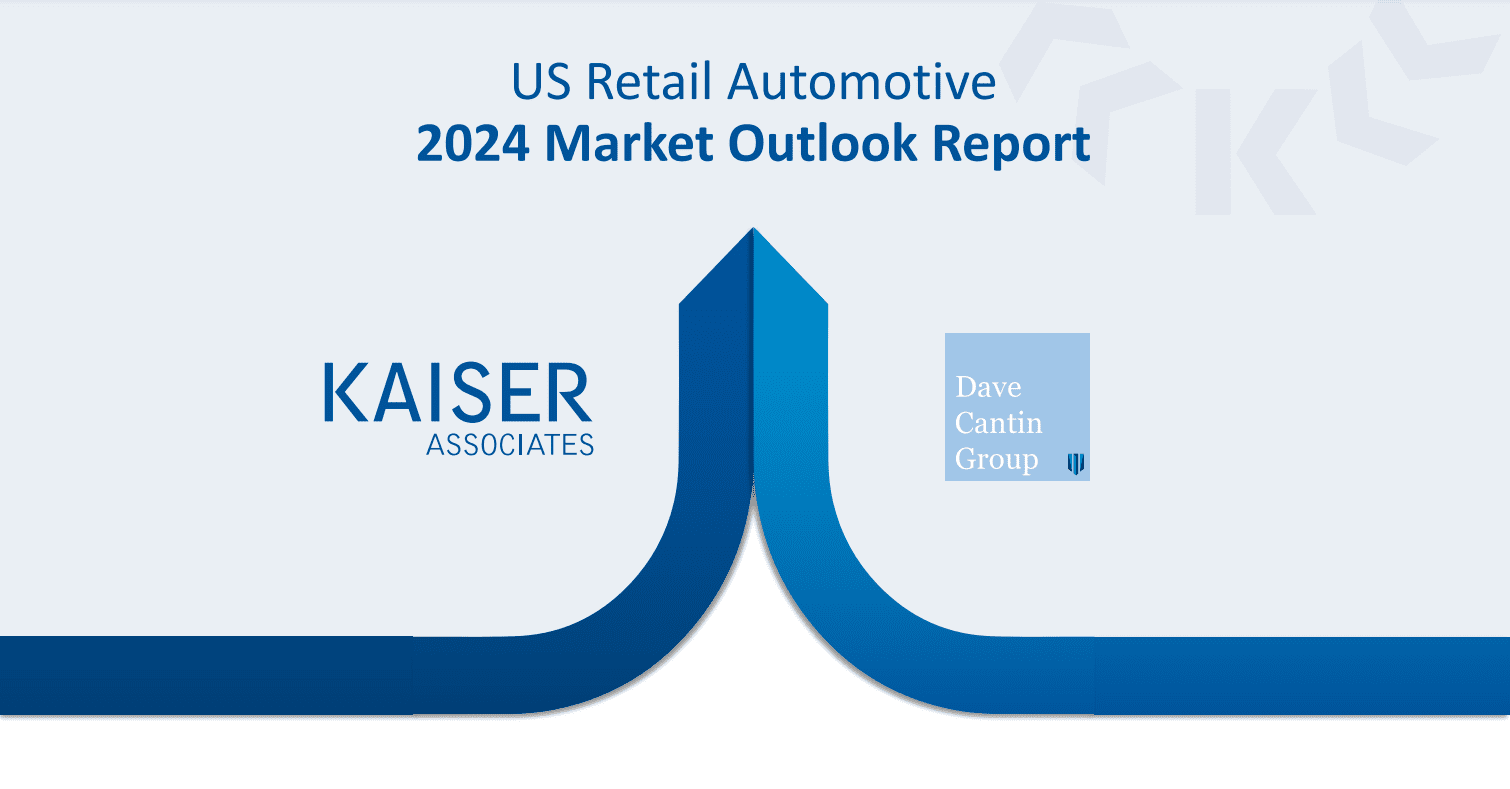While 2024 is shaping up to be to be another fascinating year for the long-term future of the car industry, the near term looks positive for OEMs, consumers and dealers, according to a new report jointly produced by the Dave Cantin Group and Kaiser Associates.
“The last four years have brought monumental changes to the present and future of the auto industry,” said Brian Gordon, Chief Business Officer at the Dave Cantin Group, a leading advisory firm to automotive retail groups and their owners. “The year 2024 looks more positive and normalized, but very real challenges remain.”
The DCG Market Outlook Report (MOR) leverages market-backed data and interviews from industry experts to deliver data and insights on the seven key themes shaping the coming year in automotive. The Market Outlook Report fills an industry gap for a report that encompasses the state of entire automotive landscape, detailing its impact on dealers, consumers and manufacturers.


“The Market Outlook Report finds industry stabilization forecasts continued strong business for manufacturers and dealers, while offering slightly better opportunities to consumers,” said Paul Mumma, a Partner at Kaiser Associates who led compilation of the DCG Market Outreach Report. “Our combined analysis and expert insights deliver the go-to guide to automotive in 2024.”
Here are the seven trends the industry must pay attention to this year.
Strong macroeconomic climate driving strong demand for new vehicles
The macroeconomic landscape has been surprisingly resilient despite the long-predicted post-pandemic economic slowdown and the persistent inflationary environment. That consumer strength will be reflected in strong demand for new vehicles. The MOR finds 68% of car shoppers plan to purchase a new vehicle, even with vehicle MSRPs and monthly payments at all-time highs. Furthermore, MOR finds approximately 25% of consumers have delayed auto purchases over the last two years due to high interest rates. Lowered rates, higher dealer inventories and pent-up demand will further fuel a strong sales year.
Coupled with higher inventory levels and lower interest rates, these positive buying trends signal strong sales and stabilizing profits for dealers and OEMs in 2024.
Changing consumer behavior doesn’t mean less driving
Car buyers are using their vehicles in different ways in the post-pandemic world. Even as fewer people are commuting to work, the MOR finds annual mileage has rebounded to near pre-Covid levels, thanks to an increase in non-work-related vehicle usage, such as recreation and running errands. And car owners aren’t replacing these activities with ridesharing, which is positive for both manufacturers and dealers. Versatility remains paramount for consumers; preferences towards light SUVs and trucks continue to trend up.
EVs are here to stay, but the market is more volatile than anticipated
EVs are at a paradoxical moment, with rising adoption and record market penetration at odds with slowing sales and heavy depreciation. Car shoppers interested in EVs are looking to international manufacturers that continue to invest in EVs due to stronger global demand. U.S. OEMs are currently scaling back EV production and future product investment due to cooling consumer demand.
The year 2024, in fact, is looking more like the year of the hybrid. Hybrids allow vehicle owners to save on fuel costs and lower their carbon footprints while maintaining similar reliability, value and performance to their ICE counterparts. Those are the three most important factors for car buyers, regardless of ICE, hybrid or EV preference, according to MOR. Furthermore, 30% of respondents say they desire a hybrid for their next vehicle.
OEMs are taking note and will continue to roll out more hybrid and plug-in hybrid models in 2024. Some vehicles, such as the stalwart Toyota Camry, will only offer a hybrid powertrain.
The political and regulatory climate is affecting EVs the most
While the current political climate has a larger-than-ever impact on the auto industry, legislation like the CARS Act and CARS Rule will not have significant impacts on dealerships if they pass, MOR forecasts.
More important will be the outcome of the presidential election on EVs. Republican or Democratic control of the White House and Congress could have significant influence on EV incentives and future EPA mandates.
OEMs continue to have an outsized importance on the value chain
Production challenges of the pandemic allowed OEMs to retain their historic grip on industry power during the pandemic, and they look to hold onto it as the industry returns to pre-pandemic production norms. Expect higher production and dealer inventory, however OEMs are cutting back on vehicle customization while pursuing larger, more technologically advanced (i.e. more expensive) products.
Expect another strong M&A year in 2024
Dealership M&A hit record highs from 2020 to 2023. While activity will cool slightly from those records, it’s expected to remain higher than the pre-Covid era.
MOR finds sustained dealer profitability has equipped dealership groups with above average cash-on-hand balances that are expected to help fuel M&A activity this year. Many of these deals will continue to be succession transactions, as the drastic industry changes happening now and a future in flux provide ideal conditions for dealer owners to retire and larger, well-funded dealer groups to acquire great platforms.
Dealer performance more important than ever
While inventory and sales volumes are expected to rise this year, MOR predicts the high margin-lower volume trend of the past three years will remain true. The promising but still volatile industry means smart, hardworking dealers with the resources to support operational efficiency will start to widen the gap over lower-performing dealers. Dealer experience is critical: while MOR finds consumers overwhelmingly still prefer brick and mortar dealers, most consumers are visiting two or more dealers before making a purchase decision.
“The industry is back to the grind in 2024. Inventory is back, the supply chain is not a blocker, and manufacturers are adjusting some of their priorities based on how consumers have pushed back over the past few years,” said Michael Brown, owner of the Empire Automotive Group. “Overall, things look more like they did pre-pandemic and it’s back to business as usual.”




